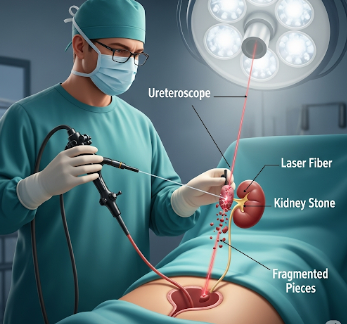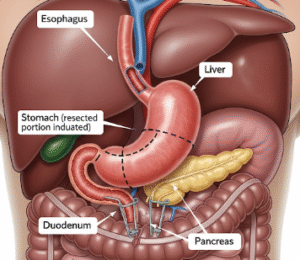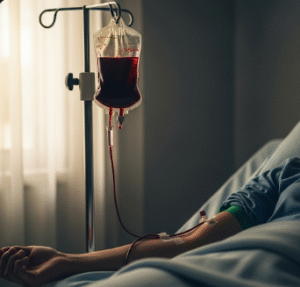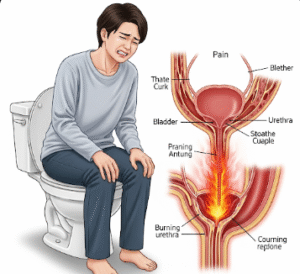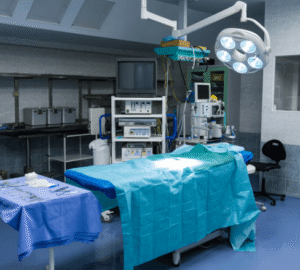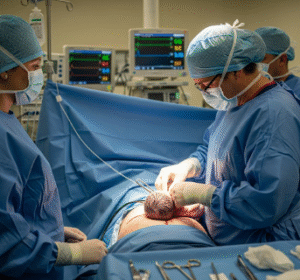Overview
Laser Lithotripsy is a minimally invasive procedure used to break kidney stones, ureteral stones, or bladder stones into smaller fragments so they can be passed naturally or removed easily. The procedure uses a high-energy laser delivered through a thin scope, allowing precise fragmentation of stones with minimal tissue damage.
In Korea, Laser Lithotripsy is performed by experienced urologists using state-of-the-art laser systems and endoscopic technology, ensuring high success rates, faster recovery, and minimal complications.
Highlights:
- ✅ Minimally invasive with high precision
- ✅ Effective for kidney, ureteral, and bladder stones
- ✅ Short recovery time with minimal pain
What is Laser Lithotripsy?
Laser Lithotripsy is a procedure in which a laser fiber is inserted through a ureteroscope or nephroscope to target and fragment urinary stones. The laser energy pulverizes the stones into tiny pieces, which can then be removed or passed naturally through urine.
Indications include:
- Kidney stones that are too large to pass naturally
- Ureteral stones causing obstruction or severe pain
- Stones resistant to shock wave therapy
- Recurrent urinary stones in high-risk patients
Important: The procedure is often preferred over open surgery due to minimal invasiveness, reduced pain, and faster recovery.
What are the benefits?
- High success rate: Effectively treats stones of various sizes and locations
- Minimally invasive: Small scope entry reduces recovery time and risk of complications
- Reduced pain: Less postoperative discomfort compared to traditional surgery
- Quick recovery: Most patients return to normal activities within a few days
Key benefits highlighted:
- ⚡ Precise targeting of stones with minimal tissue damage
- ⚡ Can treat multiple stones in a single session
- ⚡ Avoids open surgery and large incisions
Procedure Details
1) How should I prepare for Laser Lithotripsy?
- Preoperative evaluation: Blood tests, urine tests, imaging (ultrasound, CT, X-ray)
- Medication review: Stop anticoagulants or blood-thinning medications as instructed
- Fasting instructions: No food or drink for 6–8 hours prior to procedure
- Consent and education: Discuss risks, benefits, and postoperative expectations with the urologist
- Arrange support: Plan for transportation and caregiver assistance after the procedure
2) What happens during Laser Lithotripsy?
- Anesthesia: Usually general or spinal anesthesia
- Scope insertion: A ureteroscope or nephroscope is inserted through the urinary tract to the stone
- Laser fragmentation: A high-energy laser fiber is used to break the stone into smaller pieces
- Stone removal: Fragments are extracted or left to pass naturally
- Closure: No external incision is required; instruments are removed, and the patient is taken to recovery
Duration: Typically 30–90 minutes depending on stone size and location
3) What happens after Laser Lithotripsy?
- Recovery monitoring: Vital signs, urine output, and pain are observed
- Pain management: Mild discomfort is common, controlled with medications
- Hydration: Patients are encouraged to drink water to help flush stone fragments
- Follow-up care: Imaging and urine tests ensure all stone fragments are cleared
Highlights for post-procedure care:
- ⚡ Monitor for hematuria (blood in urine) or signs of infection
- ⚡ Drink plenty of water to help pass stone fragments
- ⚡ Avoid strenuous activity for a few days
- ⚡ Attend follow-up appointments to confirm stone clearance
Risks / Benefits
Risks:
- Mild bleeding or hematuria
- Infection of the urinary tract
- Injury to ureter or kidney (rare)
- Residual stone fragments requiring repeat treatment
Benefits:
- Minimally invasive with high success rates
- Fast relief from stone-related pain and obstruction
- Short hospital stay and quicker return to normal activities
- Reduced risk of complications compared to open surgery
Recovery and Outlook
- Hospital stay: Usually outpatient or 1 day
- Full recovery: Most patients resume normal activities within 2–3 days
- Long-term outlook: High likelihood of complete stone clearance, with follow-up imaging to ensure no residual stones
- Follow-up: Regular urine tests and imaging may be advised to prevent recurrence
Tips for optimal recovery:
- ✅ Stay well-hydrated to help flush residual stone fragments
- ✅ Take prescribed medications and follow pain management plan
- ✅ Avoid strenuous activity until cleared by the urologist
- ✅ Attend all follow-up visits to monitor for recurrence
When To Call the Doctor
- Persistent or worsening pain after procedure
- Fever, chills, or signs of urinary infection
- Heavy bleeding in urine or inability to urinate
- Severe nausea or vomiting
Best Korea Option / Process
Korea offers advanced Laser Lithotripsy care:
- Top hospitals: Skilled urologists and modern laser systems
- Advanced diagnostics: Ultrasound, CT, and X-ray for precise stone localization
- Surgical options: Laser lithotripsy with ureteroscope or nephroscope
- Postoperative care: Pain management, hydration support, and early mobilization
- International patient support: Online consultations, appointment scheduling, and telemedicine follow-up
Step-by-step process in Korea:
- Online consultation and review of imaging
- Preoperative evaluation and planning
- Laser lithotripsy performed by urology specialists
- Postoperative monitoring and recovery guidance
- Follow-up to ensure complete stone clearance

